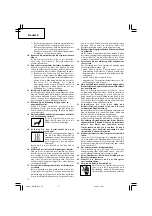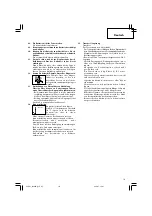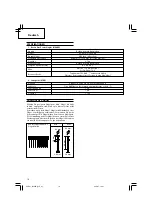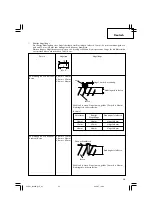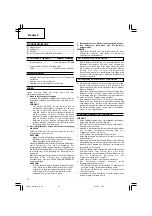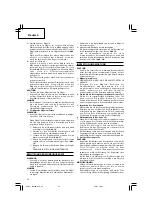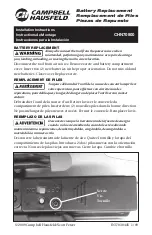
English
8
16.
Beware of the tool’s kickback.
Do not approach the top of the tool with your head
etc. during operation. This is dangerous because the
tool may recoil violently if the nail currently being
driven in comes into contact with a previous nail or
a knot in the workpiece.
17.
Take care when nailing the corners of workpiece.
When nailing thin boards, the nails may pass right
through, as may also be the case when nailing the
corners of workpiece due to deviation of the nails.
In such cases, always make sure that there is no
one (and nobody’s hands or feet; etc.) next to the
workpiece you are going to nail.
18.
Simultaneous nailing on both sides of the same wall
is dangerous.
Under no circumstances should nailing be
performed on both sides of a wall at the same time.
This would be very dangerous since the nails might
pass through the wall and thus cause injuries.
19.
Do not use the power tool on scaffoldings, ladders.
The power tool shall not be used for specific
application for example:
– when changing one driving location to another
involves the use of scaffoldings, stairs, ladders or
ladder alike constructions, e.g. roof laths,
– closing boxes or crates,
– fitting transportation safety systems e.g. on
vehicles and wagons
20.
Disconnect the battery and fuel cell and take out
any nails left in the magazine after use.
Disconnect the battery and fuel cell from the tool
before doing tool maintenance, cleaning a jammed
fastener, leaving work area, moving tool to another
location, or after use. It is very dangerous for a nail
to be fired by mistake.
21.
When removing a nail which has become stuck,
make sure to first of all disconnect the battery and
fuel cell.
When removing a nail which has become stuck in
the nail outlet, first of all make sure to disconnect
the battery and fuel cell inside the power tool.
Accidental firing of the nail could be very dangerous.
22.
The operating environment for this device is
between 0°C (32°F) and 40°C (104°F) so ensure use
within this temperature range. The device may fail
to operate below 0°C (32°F) or above 40°C (104°F) .
23.
Always charge the battery at an ambient
temperature of 0–40°C.
A temperature of less than 0°C will result in over
charging which is dangerous. The battery cannot
be charged at a temperature greater than 40°C.
The most suitable temperature for charging is that
of 20–25°C.
24.
Do not use the charger continuously.
When one charging is completed, leave the charger for
about 15 minutes before the next charging of battery.
25.
Do not allow foreign matter to enter the hole for
connecting the rechargeable battery.
26.
Never disassemble the rechargeable battery or
charger.
27.
Never short-circuit the rechargeable battery.
Short-circuiting the battery will cause
a great electric current and overheat.
It results in burn or damage to the
battery.
28.
Do not dispose of the battery in fire.
If the battery is burnt, it may explode.
29.
Using an exhausted battery will damage the
charger.
30.
Bring the battery to the shop from which it was
purchased as soon as the post-charging battery life
becomes too short for practical use.
Do not dispose of the exhausted battery.
31.
Do not insert objects into the air ventilation slots
of the charger.
Inserting metal objects or flammable into the
charger air ventilation slots will result in an electrical
shock hazard or damage to the charger.
32.
Do not inhale its contents.
In case of being inhaled ; the person
affected should be taken into the
open air and brought into a
comfortable position.
33.
Expanding gases cause low temperatures.
Fluid gases might cause injuries when getting in
touch with skin or eyes.
– In case of contact with skin; wash the contact
surface carefully with warm water and soap and
apply a skin cream when dry.
– In case of contact with eyes; rinse the open eyes
under running water.
Contact a doctor if necessary.
34.
Fuel cells.
Store in well–ventilated area.
Do not store above 50°C (120°F)
(e.g. direct sunlight or in a vehicle).
Do not expose to an open flame
and sparks.
Do not puncture or open the fuel cell.
Do not refill, reclaim or recycle the fuel cell.
Dispose of according to local regulations for aerosol
products.
Do not dispose of fuel cell with other scrap for
recycling.
Keep out of reach of children.
35.
Transportation/Storage.
Transportation
Shipment per mail is not allowed.
– Transportation of small quantities for own use in
private car is allowed without shipping papers and
emergency card.
– Observe temperature limit of 50°C (120°F).
Storage
– Do not store in passages, entry halls, near
doors/exit or attic.
– Sales booths should not be close exits.
– A fire extinguisher of 6 kg, class A, B, C must be
available.
– Packages should be stacked up not to fall to the
ground.
– Store rooms must not take more than 20 m
2
of
room surface.
– Do not store together with pyrotechnical goods.
– The quantity stored in sales rooms should not
exceed daily sales.
– Tools with an open flame or high temperature
must not be operated near fuel cells.
– Fuel cells must not be displayed in shop windows.
MAX 50°C
(120°F)
01Eng_NC40G_WE_6L
6/15/07, 12:01
8
Содержание NC 40G
Страница 76: ...75 07Back_NC40G_WE_6L 5 7 07 10 33 75 ...
Страница 78: ...77 07Back_NC40G_WE_6L 6 15 07 12 04 77 ...
Страница 79: ...78 07Back_NC40G_WE_6L 6 15 07 12 04 78 ...
Страница 80: ...79 07Back_NC40G_WE_6L 6 15 07 12 04 79 ...


















